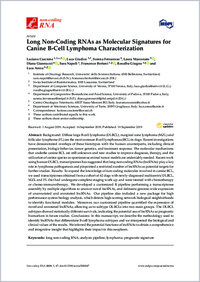Long non-coding RNAs as molecular signatures for canine B-Cell lymphoma characterization
- Cascione, Luciano Institute of Oncology Research (IOR), Faculty of Biomedical Sciences, Università della Svizzera italiana, Switzerland - Swiss Institute of Bioinformatics, 1000 Lausanne, Switzerland
- Giudice, Luca Department of Computer Science, University of Verona, 37100 Verona, Italy
- Ferraresso, Serena Department of Comparative Biomedicine and Food Science, University of Padova, 35100 Padova, Italy
- Marconato, Laura Centro Oncologico Veterinario, 40037 Sasso Marconi BO, Italy
- Giannuzzi, Diana Department of Comparative Biomedicine and Food Science, University of Padova, 35100 Padova, Italy
- Napoli, Sara Institute of Oncology Research (IOR), Faculty of Biomedical Sciences, Università della Svizzera italiana, Switzerland
- Bertoni, Francesco Institute of Oncology Research (IOR), Faculty of Biomedical Sciences, Università della Svizzera italiana, Switzerland
- Giugno, Rosalba Department of Computer Science, University of Verona, 37100 Verona, Italy
- Aresu, Luca Department of Veterinary Sciences, University of Turin, 10095 Grugliasco, Italy
-
19.09.2019
Published in:
- Non-coding RNA. - 2019, vol. 5, no. 3, p. 47
English
Diffuse large B-cell lymphoma (DLBCL), marginal zone lymphoma (MZL) and follicular lymphoma (FL) are the most common B-cell lymphomas (BCL) in dogs. Recent investigations have demonstrated overlaps of these histotypes with the human counterparts, including clinical presentation, biologic behavior, tumor genetics, and treatment response. The molecular mechanisms that underlie canine BCL are still unknown and new studies to improve diagnosis, therapy, and the utilization of canine species as spontaneous animal tumor models are undeniably needed. Recent work using human DLBCL transcriptomes has suggested that long non-coding RNAs (lncRNAs) play a key role in lymphoma pathogenesis and pinpointed a restricted number of lncRNAs as potential targets for further studies. Results: To expand the knowledge of non-coding molecules involved in canine BCL, we used transcriptomes obtained from a cohort of 62 dogs with newly-diagnosed multicentric DLBCL, MZL and FL that had undergone complete staging work-up and were treated with chemotherapy or chemo-immunotherapy. We developed a customized R pipeline performing a transcriptome assembly by multiple algorithms to uncover novel lncRNAs, and delineate genome-wide expression of unannotated and annotated lncRNAs. Our pipeline also included a new package for high performance system biology analysis, which detects high-scoring network biological neighborhoods to identify functional modules. Moreover, our customized pipeline quantified the expression of novel and annotated lncRNAs, allowing us to subtype DLBCLs into two main groups. The DLBCL subtypes showed statistically different survivals, indicating the potential use of lncRNAs as prognostic biomarkers in future studies. Conclusions: In this manuscript, we describe the methodology used to identify lncRNAs that differentiate B-cell lymphoma subtypes and we interpreted the biological and clinical values of the results. We inferred the potential functions of lncRNAs to obtain a comprehensive and integrative insight that highlights their impact in this neoplasm.
- Language
-
- English
- Classification
- Medicine
- License
- Open access status
- gold
- Identifiers
-
- RERO DOC 328277
- DOI 10.3390/ncrna5030047
- ARK ark:/12658/srd1319076
- Persistent URL
- https://n2t.net/ark:/12658/srd1319076
Statistics
Document views: 156
File downloads:
- Texte intégral: 187
